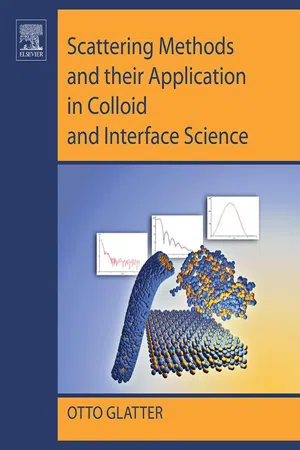
This is a test
- 404 pages
- English
- ePUB (mobile friendly)
- Available on iOS & Android
eBook - ePub
Scattering Methods and their Application in Colloid and Interface Science
Book details
Book preview
Table of contents
Citations
About This Book
Scattering Methods and their Application in Colloid and Interface Science offers an overview of small-angle X-ray and neutron scattering techniques (SAXS & SANS), as well as static and dynamic light scattering (SLS & DLS). These scattering techniques are central to the study of soft matter, such as colloidal dispersions and surfactant self-assembly. The theoretical concepts are followed by an overview of instrumentation and a detailed description of the evaluation techniques in the first part of the book. In the second part, several typical application examples are used to show the strength and limitations of these techniques.
- Features the latest input from the world-leading expert with personal experience in all the fields covered (SAXS, SANS, SLS and DLS)
- Includes unified notation throughout the book to enhance its readability
- Provides—in a single source—scattering theory, evaluation of techniques and a variety of applications
Frequently asked questions
At the moment all of our mobile-responsive ePub books are available to download via the app. Most of our PDFs are also available to download and we're working on making the final remaining ones downloadable now. Learn more here.
Both plans give you full access to the library and all of Perlego’s features. The only differences are the price and subscription period: With the annual plan you’ll save around 30% compared to 12 months on the monthly plan.
We are an online textbook subscription service, where you can get access to an entire online library for less than the price of a single book per month. With over 1 million books across 1000+ topics, we’ve got you covered! Learn more here.
Look out for the read-aloud symbol on your next book to see if you can listen to it. The read-aloud tool reads text aloud for you, highlighting the text as it is being read. You can pause it, speed it up and slow it down. Learn more here.
Yes, you can access Scattering Methods and their Application in Colloid and Interface Science by Otto Glatter in PDF and/or ePUB format, as well as other popular books in Technology & Engineering & Chemical & Biochemical Engineering. We have over one million books available in our catalogue for you to explore.
Information
Chapter 1
Interference, Rayleigh–Debye–Gans Theory
Abstract
This chapter gives an overview of the principles of small-angle X-ray and neutron scattering. The description of these scattering experiments is based on the interference of coherently scattered waves. The phase difference of waves that come from different scattering centers is based on the path length difference. The Rayleigh–Debye–Gans theory of scattering is the rigorous application of the idea of coherent interference to scattering, assuming that the wave propagates into and through the particle regularly and homogeneously. Here we are dealing only with dilute, monodisperse, nonoriented systems. This means one has to average over all orientations in space, and particle interactions can be ignored. The angle-dependent scattering intensity, the form factor, is related to the particle pair–distance distribution function by a Fourier transformation. The scatterers may also be characterized by their correlation function, correlation length, and chord distribution in real space, or by their second moment—the invariant—in reciprocal space.
Keywords
Correlation function; form factor; interference; invariant; Rayleigh–Debye–Gans theory; pair–distance distribution function
Interference of Scattered Waves
When an electromagnetic wave is sent through a thin slab of material, the electric field will introduce a polarization of the atoms, leading to the formation of little dipoles. The electric field oscillates with a frequency that is defined by the wavelength of the radiation sent into the material, so the dipoles will oscillate in a forced motion with the same frequency.
Around the turn of the last century, H.A. Lorentz1 developed a classical theory of the optical properties of matter. He treated electrons and ions as simple harmonic oscillators (springs), which are moved by the driving force of the electromagnetic field. The results of this procedure are qualitatively identi...
Table of contents
- Cover image
- Title page
- Table of Contents
- Copyright
- Preface
- Chapter 1. Interference, Rayleigh–Debye–Gans Theory
- Chapter 2. General Theorems and Special Cases
- Chapter 3. The Inverse Scattering Problem
- Chapter 4. Concentration Effects, Interactions
- Chapter 5. Absolute Intensity, SAXS, and SANS
- Chapter 6. Contrast Variation
- Chapter 7. Instrumentation for SAXS and SANS
- Chapter 8. Numerical Methods
- Chapter 9. Static Light Scattering From Small Particles
- Chapter 10. Light Scattering From Large Particles: Lorenz−Mie Theory
- Chapter 11. Dynamic Light Scattering (DLS)
- Chapter 12. Dilute Systems: Practical Aspects—Applications
- Chapter 13. Concentrated, Interacting Systems: Practical Aspects, Applications
- Chapter 14. Glasses, Liquid Crystals, and Gels
- Appendix
- References
- Index